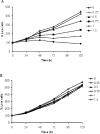Ethanol elicits inhibitory effect on the growth and proliferation of tongue carcinoma cells by inducing cell cycle arrest
- PMID: 22802695
- PMCID: PMC3394916
- DOI: 10.4196/kjpp.2012.16.3.153
Ethanol elicits inhibitory effect on the growth and proliferation of tongue carcinoma cells by inducing cell cycle arrest
Abstract
Cellular effects of ethanol in YD-15 tongue carcinoma cells were assessed by MTT assay, caspase activity assay, Western blotting and flow cytometry. Ethanol inhibited the growth and proliferation of YD-15 cells in a dose- and time-dependent manner in an MTT assay. The effects of ethanol on cell cycle control at low percent range of ethanol concentration (0 to 1.5%), the condition not inducing YD-15 cell death, was investigated after exposing cells to alcohol for a certain period of time. Western blotting on the expression of cell cycle inhibitors showed that p21 and p27 was up-regulated as ethanol concentration increases from 0 to 1.5% whilst the cell cycle regulators, cdk1, cdk2, and cdk4 as well as Cyclin A, Cyclin B1 and Cyclin E1, were gradually down-regulated. Flow cytometric analysis of cell cycle distribution revealed that YD-15 cells exposed to 1.5% ethanol for 24 h was mainly arrested at G2/M phase. However, ethanol induced apoptosis in YD-15 cells exposed to 2.5% or higher percent of ethanol. The cleaved PARP, a marker of caspase-3 mediated apoptosis, and the activation of caspase-3 and -7 were detected by caspase activity assay or Western blotting. Our results suggest that ethanol elicits inhibitory effect on the growth and proliferation of YD-15 tongue carcinoma cells by mediating cell cycle arrest at G2/M at low concentration range and ultimately induces apoptosis under the condition of high concentration.
Keywords: Cell cycle arrest; Cell growth; Ethanol; Tongue carcinoma cell.
Figures






Similar articles
-
The Inhibitory Effect of Buddlejasaponin IV on the Growth of YD-10B Human Oral Squamous Cell Carcinoma Cells.J Cancer Prev. 2013 Dec;18(4):330-6. doi: 10.15430/jcp.2013.18.4.330. J Cancer Prev. 2013. PMID: 25337562 Free PMC article.
-
Antitumor and apoptosis-inducing effects of α-mangostin extracted from the pericarp of the mangosteen fruit (Garcinia mangostana L.)in YD-15 tongue mucoepidermoid carcinoma cells.Int J Mol Med. 2016 Apr;37(4):939-48. doi: 10.3892/ijmm.2016.2517. Epub 2016 Mar 4. Int J Mol Med. 2016. PMID: 26951885 Free PMC article.
-
A monomer purified from Paris polyphylla (PP-22) triggers S and G2/M phase arrest and apoptosis in human tongue squamous cell carcinoma SCC-15 by activating the p38/cdc25/cdc2 and caspase 8/caspase 3 pathways.Tumour Biol. 2016 Nov;37(11):14863-14872. doi: 10.1007/s13277-016-5376-4. Epub 2016 Sep 19. Tumour Biol. 2016. PMID: 27644244
-
Arsenic trioxide-mediated growth inhibition in MC/CAR myeloma cells via cell cycle arrest in association with induction of cyclin-dependent kinase inhibitor, p21, and apoptosis.Cancer Res. 2000 Jun 1;60(11):3065-71. Cancer Res. 2000. PMID: 10850458
-
Chelidonine induces mitotic slippage and apoptotic-like death in SGC-7901 human gastric carcinoma cells.Mol Med Rep. 2016 Feb;13(2):1336-44. doi: 10.3892/mmr.2015.4683. Epub 2015 Dec 14. Mol Med Rep. 2016. PMID: 26677104
Cited by
-
Modelling and Differential Quantification of Electric Cell-Substrate Impedance Sensing Growth Curves.Sensors (Basel). 2021 Aug 5;21(16):5286. doi: 10.3390/s21165286. Sensors (Basel). 2021. PMID: 34450726 Free PMC article.
-
Evaluating the influence of common antibiotics on the efficacy of a recombinant immunotoxin in tissue culture.BMC Res Notes. 2019 May 27;12(1):293. doi: 10.1186/s13104-019-4337-6. BMC Res Notes. 2019. PMID: 31133049 Free PMC article.
References
-
- Figuero Ruiz E, Carretero Peláez MA, Cerero Lapiedra R, Esparza Gómez G, Moreno López LA. Effects of the consumption of alcohol in the oral cavity: relationship with oral cancer. Med Oral. 2004;9:14–23. - PubMed
-
- Chen AY, Myers JN. Cancer of the oral cavity. Curr Probl Surg. 2000;37:633–731. - PubMed
-
- Stewart BW, Kleihues P. World cancer report. Lion: IARC; c2003. pp. 22–32.
-
- Silverman S., Jr Demographics and occurrence of oral and pharyngeal cancers. The outcomes, the trends, the challenge. J Am Dent Assoc. 2001;132(Suppl):7S–11S. - PubMed
-
- Wight AJ, Ogden GR. Possible mechanisms by which alcohol may influence the development of oral cancer--a review. Oral Oncol. 1998;34:441–447. - PubMed
LinkOut - more resources
Full Text Sources
Research Materials
Miscellaneous

